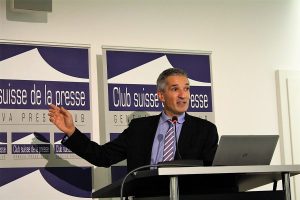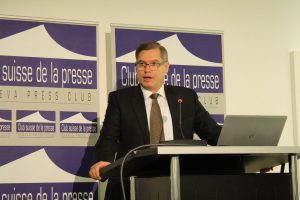At a time of critical transition in the energy sector it is increasingly important for leading players in the gas industry to have a neutral and independent arena to exchange views, share best practices and ensure that the role of natural gas in the wider energy system is understood with clearly defined policy and market frameworks.
Speaking at a press conference ‘Gas markets, projects, challenges and role of natural gas in the future’, at the Geneva Press Club, World Energy Council Secretary General, Dr Christoph Frei, talked about the future of gas in the context of the Council’s recent World Energy Scenarios 2016 report, as well as an overview of the high-level discussions held at the 23rd World Energy Congress in October.
“So, not only do we see a slowing down of global growth, but also an acceleration in the decoupling of energy from GDP, this leads us as to the question about when energy demand will peak. This provides a very different context which we recognised and discussed at this year’s congress."
"Our Scenarios highlight the full range of problems the energy sector is facing and what the possibilities are for new realities going forward. We distinguish three fundamental realities."
“There are three worlds, the first we are describing is Modern Jazz, it’s all about the consumer wanting things cheap and immediately in a world which enables markets, domestic market frameworks as well as international trade."
“The second world named Unfinished Symphony is a very different world in which leader work together with the aim of achieving tomorrow’s prosperity objectives. These typically include climate change mitigation aspirations through international agreements like the Paris agreement. It is more orchestrated in nature. We are top-down choosing technology that gets us a step closer, which may seem expensive in the short term, but one which clearly goes after more critical problems."
“But what if we see neither of the first two worlds being a reality…what if we do not realise the power of markets nor deliver the leadership it takes to reach climate agreements? We then end up in a world what we refer to as Hard Rock which represents a more inward looking world. A world defined by mistrust of your neighbour including when it comes to energy dependency; a world in which we see trade barriers instead of trade agreements; a world, in which we focus on domestic sources including coal. It is important to recognise the fundamentally different nature and outcomes of all three scenarios."
“On the energy side we see ‘primary per capita energy demand’ peaking before 2030. It’s the first time the Council or any important energy organisation says this."
“Among the fossil fuels, natural gas is the one fossil source which will continue to grow. Simply because it’s the one that has the most advantages when it comes to CO2 emissions by substitution coal on the electricity side or oil on the transport side and the gas network also represents significant storage opportunities."
The rate of natural gas growth varies broadly across the three scenarios. Modern Jazz sees the rise of LNG and the largest role for natural gas. Technology developments continue in unconventional gas led by North America and later Argentina, China, and Australia. Hard Rock also sees growth driven by unconventionals, but lower gas trade and reduced technology transfer make resources more expensive. Stringent emissions mandates in Unfinished Symphony mean gas grows more slowly.
Gasification is also an increasingly significant trend. City fleets, long-haul trucking and inland marine vessels will be behind most of the growth in the use of natural gas as a transportation fuel. With the recent treaty between OECD countries to restrict the use of bunker fuels within 200 miles of members’ coastlines, the marine sector is reconsidering its fuel needs. Consumers, organisations and countries increasingly want cleaner, lower-carbon-intensive energy of all types to meet their needs.
As a high-level platform to shape the natural gas agenda, the Global Gas Centre was established at the beginning of 2015 with the support of its founding members: Swissgas, ENGIE, OMV and the World Energy Council, which also acts as host to the organisation.
Through Global Gas Centre events and dedicated sessions at the World Energy Council’s global energy leaders’ events, the Global Gas Centre programme encompasses international perspectives and provides a global platform for its members.
Content alignment with the Council’s strategic studies – including the World Energy Trilemma, Scenarios, Resources, and Issues Monitor – provides strategic insights on the future of natural gas and cross-cutting expertise beyond the sector.







